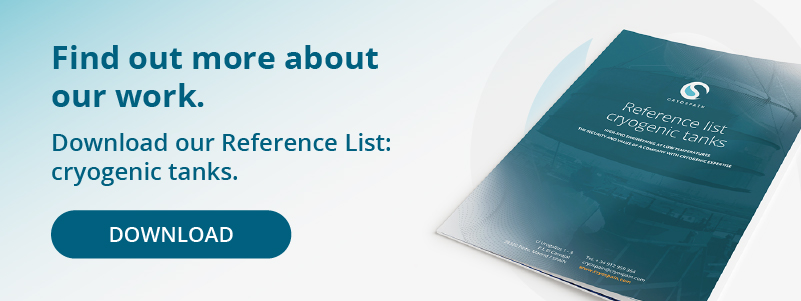Cryogenic tanks are an essential part for many industries, as they are a key element to store certain gases crucial for diverse processes. In light of such importance, we take a look at the different possibilities in the current cryogenic tanks market and provide 4 key questions to answer before acquiring a cryogenic container.
Use and utility of cryogenic tanks
Cryogenic tanks are a type of industrial storage tank ideal for situations where large quantities of gas need to be stored in liquid form.
They are the right solution to store substances such as Liquid Oxygen, Liquid Nitrogen, Argon, C02, LNG, LPG, Liquid Hydrogen, etc, all of which must be stored at very low temperatures in order to maintain their properties. Thus, it’s common to hear of a cryogenic oxygen tank, a LNG cryogenic tank, and so forth.
As more and more industries require the gases mentioned above, demand for cryogenic tanks keeps growing and is projected to grow at a higher rate than 5% CAGR between 2020 and 2026.
The main characteristics of an adequate cryogenic storage tank include:
- They’re versatile, provide an optimal internal distribution and thus optimize resources. They allow for the installation of a centralised network for the optimal distribution of the different cryogenic gases used, so that there is no gas return to the plant
- Improved loading process through the use of vaporisers, so that the liquid gas passes directly from the production plant to the user, avoiding sudden movements and improving stability and safety.
- Higher purity than other storage systems, as the gas remains isolated in a hermetically sealed tank so that the possibility of contamination with any external agents is minimized.
- Because they’re hermetically sealed, they remain stable and thus are safer than other storage alternatives. Also, as the cylinder transfer within the facilities is avoided, unnecessary risks aren’t taken.
Related content: Cryogenic dewar: tips for a safe, optimized storage
Types of cryogenic tanks
The structure for cryogenic tanks is made of three parts:
- An inner vessel made of stainless steel and designed to withstand very low temperatures.
- An outer vessel made of carbon steel. In order to guarantee cryogenic temperatures and safety, these two vessels are insulated from each other by a combination of materials that provide such insulation.
- In addition to these two containers, a cryogenic storage tank is also equipped with a pressure regulation system, which is specifically designed to ensure that the cryogenic tank always operates at a constant pressure. At the same time, this pressure is set with the user’s needs in mind.
While cryogenic tanks have this basic structure in common, it’s possible to distinguish between two types of cryogenic container:
- Flat-bottom cryogenic tanks, such as the flat-bottomed tanks Cryospain has recently installed in the USA.
- Large vacuum-insulated cryogenic pressure vessels, such as the new vacuum insulated vessels Cryospain has generated in collaboration with IDESA, which allow for large-scale cryogenic storage.
How to choose a cryogenic container?
Depending on the substance to be stored
When choosing cryogenic tanks, companies must consider what substances they need to store, and communicate it to the tanks manufacturer.
Different substances will require a different tank shape and design, so that it perfectly adapts to the cryogenic liquid it will need to store.
Some common substances that require a cryogenic container include:
- LIN (liquid nitrogen)
- LOX (Liquid Oxygen)
- LAR (Liquid Argon)
- CO2 (Carbon Dioxide)
- LNG (Liquefied Natural Gas)
- LHe (Liquid Helium)
- LH2 (Liquid Hydrogen)
- LPG ( Liquefied Petroleum Gas)
- Liquid Ethylene
Depending on the size
Different companies will be in need of different tank sizes, depending on their substance demand and use, among other factors. At Cryospain we are specialized in tanks for large quantities >500 m3
Depending on the material
Stainless steel and carbon steel are the main two materials for building cryogenic tanks. At the same time, different insulating materials can be used: from cellular glass, to rockwool and expanded perlite. Thus, each project must be studied separately, in order to ensure the right materials are used.
Other considerations
Other criteria to pick the right cryogenic tanks can include:
- The need to comply with national and/or international regulations.
- The geographical location where the tanks will be installed. For instance, seismic criteria must be considered. The difficulty to access the are might also present a challenge, like it did when Cryospain built a flat-bottom cryogenic tank in Santa Cruz, Bolivia.
Keep reading: Everything you need to know when choosing cryogenic tanks for gas storage
At Cryospain we develop custom flat-bottom cryogenic tanks, as well as large vacuum-insulated cryogenic pressure vessels, all according to our clients’ needs as well as international and local regulations.
We are in charge of designing these cryogenic tanks from the first sketches through to construction and commissioning, coordinating our design, engineering and production teams.
In order to take into account our clients’ needs and to guarantee a smooth implementation, we provide a careful design process through computer-aided systems, which provide virtual simulations of the future cryogenic tanks.
Thus, as part of the cryogenic tanks market, we generate tailored cryogenic storage solutions, designed and built by our experts. Want to learn more about cryogenic tanks and how to pick the right one for your business? Get in touch with us.











 Contacte-nos
Contacte-nos